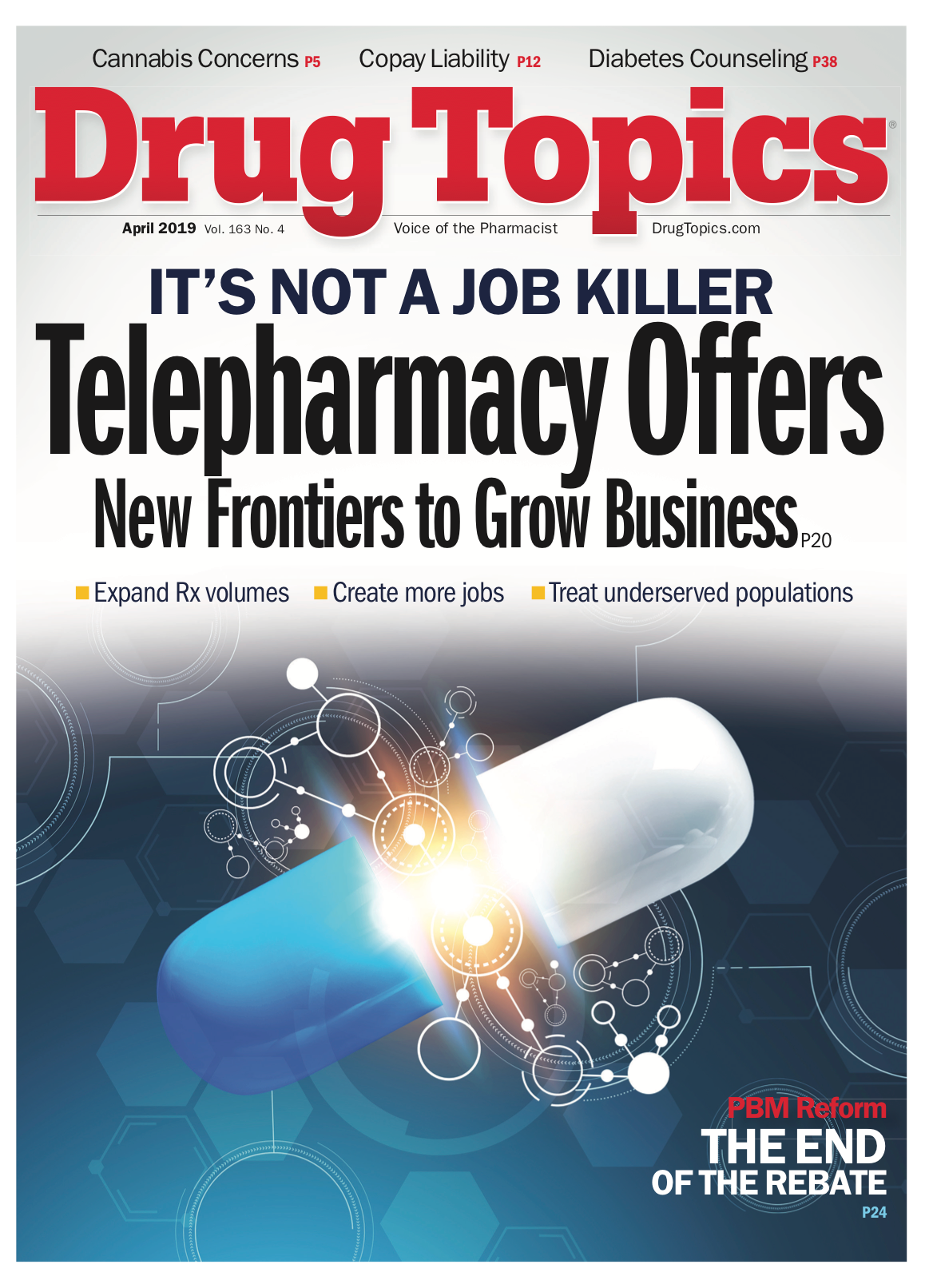Clinical Pharmacists Are Integral Team Members in PCMHs

As pharmacists struggle to practice at the top of their licenses and become a recognized and integral part of a care team, these goals are coming to fruition in patient-centered medical homes (PCMHs).
The Agency for Healthcare Research and Quality’s definition of a PCMH emphasizes a care team that includes pharmacists, physicians, advanced practice nurses, physician assistants, nurses, nutritionists, social workers, educators, and care coordinators as key elements. The team provides comprehensive and coordinated care centered around the patient.
The American College of Clinical Pharmacy (ACCP) believes that clinical pharmacists should enhance the care provided by collaborating professionals by sharing their pharmacotherapeutic expertise-rather than serving as a substitute or extender.
Daniel Aistrope, PharmD, BCACP, director of clinical practice advancement for ACCP, considers comprehensive medication management (CMM)-a clinical service that includes an individualized care plan to achieve the intended goals of therapy with appropriate follow-up to determine actual patient outcomes-to be the primary responsibility of a pharmacist in a PCMH.
Aistrope provides support and consultation to members across the country seeking to develop and advance clinical pharmacy services integrated into team-based medical practices, including the implementation of CMM.
Trending: Rise in Global Travel Fuels Business Opportunities
According to the ACCP, patients who could benefit from CMM include those who:
- Have not reached or are not maintaining their intended therapy goal.
- Are experiencing adverse effects from their medications.
- Have difficulty understanding or following a medication regimen.
- Need preventive therapy.
- Are often readmitted to the hospital.
“It’s one thing to put therapy problems on paper, but another to bring solutions to reality through team-based care,” Aistrope says. “Optimizing medication therapy is a primary goal in a medical home.”
Pharmacists in PCMHs
Five clinical pharmacists who practice in PCMHs shared their experience with Drug Topics. They have many of the same responsibilities, benefit from many of the same advantages of the setting, and face similar challenges.
In general, their duties include reviewing patients’ medical profiles, reconciling medications, evaluating lab results, assessing the appropriateness of drugs, finding drug-related problems, educating patients, developing a care plan, and following up.
Many PCMHs rely on population management tools to resolve pharmacy-related problems, including registries that:
- Highlight how well patients as a whole and as individuals are achieving certain quality measures and reaching medication goals.
- Find possible pitfalls, such as patients not on appropriate effective medications or who are nonadherent to a drug regimen.
- Identify patients with certain chronic diseases to uncover medication intolerance, side effects, and trouble with polypharmacy.
“These tools help with adherence and indicate if medications need adjustment,” says Liza W. Claus, PharmD, assistant professor and clinical pharmacist at the University of Colorado Anschutz Campus in Aurora.
Kelly Cochran, PharmD, clinical associate professor at the University of Missouri-Kansas City School of Pharmacy and a clinical pharmacist at the University of Missouri General Internal Medicine Clinic in Columbia, serves in a consulting role as part of a collaborative team of primary care physicians, behavioral health professionals, nurse care coordinators, and a dietitian.
FDA Update: Balversa Fast-Tracked for Bladder Cancer
The interpersonal and interdisciplinary approach enhances the level of care, Cochran says, and enables the team to better understand patient problems-including social determinants of health-and help solve them. Her team lacks a social worker, which Cochran believes would be a valuable resource, along with additional providers.
Similar to clinical pharmacists in other medical homes, Cochran has access to EHRs, lab data, and patient medical histories, which most community pharmacists do not. She says the information enables her to make ongoing changes in medication therapy.
She and other clinical pharmacists in her practice are part of a collaborative practice agreement with one or more physicians that allows them to assume professional responsibility for performing patient assessments; order medication-related laboratory tests; select, initiate, and monitor medications; and adjust medication regimens.
Medical Home versus Community Pharmacists
“There’s a big difference in the work that pharmacists can do in a medical home compared to a typical community pharmacy setting,” says Daniel Rehrauer, PharmD, of HealthPartners in Minneapolis. “Working in a medical home, you have access to medical records and work side by side with other members of a care team. If I am working with a patient on a medication issue and discover the real problem is diet related, I can walk down the hall and talk to the dietician or just send a referral. That is much more difficult to do in a community pharmacy setting. With that being said, there are opportunities for community pharmacists to make inroads and form partnerships with local providers,” he says.
“The medical home, however, is what will allow organizations to have success in these new payment models and to spend more time on providing care than on figuring out payment,” he says.
Liza W. Claus, PharmD, of the University of Colorado Anschutz Campus in Aurora, draws some similarities between her role in a medical home with that of a community pharmacist. “Both are concerned with medication safety and appropriateness and counsel patients using a medication for the first time or having trouble with a particular drug,” she says.
“One key difference is the location” Claus says. A clinic with close proximity to other providers “creates a physically integrated team giving pharmacists the ability to manage therapy under collaborative protocols.”
Kyle Turner, PharmD, of University of Utah Health, says community pharmacists optimize medications for patients, but their emphasis is on how to take drugs to boost adherence, while in his role in a PCMH, he also manages a patient’s entire drug regimen. “For us, medication therapy management is a marathon, not a sprint,” he says.
One big difference, says Allyson Schlichte, PharmD, of Fairview Uptown Clinic in Minneapolis, is her ability to form relationships with prescribers, which was missing when she served as a community pharmacist. On the other hand, she believes that community pharmacists touch patients more than she does in the clinic and that they are able to reinforce how to take certain medications appropriately.
Continue reading on page 2...
A PCMH’s Heart
At the heart of a PCMH is integration and coordination, says Daniel Rehrauer, PharmD, senior manager of medication therapy management (MTM) for HealthPartners in Minneapolis, an integrated healthcare system. The PCMH has 23 pharmacists and two pharmacy residents, along with a social worker, diabetes educator, physicians, and nurses at 30 sites. It also partners with more than 100 community pharmacists and serves 1.2 million patients.
He is responsible for overseeing MTM benefits across the system, optimizing medication use for complex patients-most of whom are on multiple medications-or for those struggling with their prescriptions in ways that could result in poorer disease control.
“I look at a person’s entire drug regimen to ensure it has the right mix and make a referral to another provider if necessary. You have to study the whole picture,” he says.
Chains & Business: Walgreens Ups Competition with New Primary Care Model
Rehrauer says that access to patient medical records, documentation from other providers, and shared care plans enables pharmacists to understand when it makes sense to get involved. “This coordination makes it easier to make changes because the system is built to support those decisions,” he says.
On the other hand, Rehrauer faces a challenge recognized by his peers-being able to tell other health professionals of how pharmacists can add value and how it is worth it for medical homes to invest in adding pharmacists to the staff. He says he has successfully accomplished that at HealthPartners.
PCMH Pharmacists as Consultants
Like her counterparts, Claus serves in a pharmacotherapy consulting position aligned with primary care physicians and other team members, including a behavioral healthcare professional, social worker, case managers, a podiatrist, sports medical specialists, telepsychiatry, and a physician assistant. Serving 16,400 people, there are 46 providers (or the equivalent of 12 full-time people) in the PCMH, which also serves as a training site for both pharmacy and medical residents.
Claus also has a part-time practice partner and works with three PGY-2 ambulatory care pharmacy residents, one of whom is with her on a daily basis.
She applies her pharmacy expertise to about 50% of patients who come to the clinic. Most of the patients who receive CMM suffer from chronic diseases such as diabetes and hypertension and are taking multiple drugs. Claus reviews patients’ drug and medical histories to ensure all disease states are being treated safely and effectively and are linked to the right indication, and to avoid drug interactions and side effects.
Continue reading on page 3...
Serving as Providers
Fairview Health Services has provided MTM services in its clinics-24 primary care and 10 specialty-since 1998. Its MTM pharmacists have cared for 10,901 patients with about double the number of visits in 2018, and have identified more than 130,000 drug therapy problems since the program’s inception.
Allyson Schlichte, PharmD, MTM operations lead and MTM provider at Fairview Uptown Clinic in Minneapolis, says she saw 253 patients with 533 encounters in 2018, to initiate, stop, or change drug regimens. Like her peers, she has a collaborative practice agreement with physicians in her clinic.
In addition to eight physicians, her team includes a social worker, care coordinator, eight medical assistants, four triage nurses, and a PGY-1 pharmacy resident, with access to specialists and a diabetes educator.
“I am looking at the same outcomes as physicians, while also fine-tuning drugs to fit patients’ lifestyles,” she says. “I use layperson’s terms to ensure patients understand why they are taking their drugs and how to take them, while tackling personal and clinical issues to achieve goals.”
In her role at Fairview, Schlichte addresses chronic conditions, including diabetes, depression, hypertension, and asthma for patients discharged from a hospital or referred by her team members.
She focuses her attention on:
- Indication-whether a drug aligns with a clinical problem.
- Effectiveness.
- Safety-interactions and side effects.
- Convenience-which leads to better adherence when patients know how to take their drugs appropriately.
Read More: Telelpharmacy's New Fronteirs Expand Business Opportunities
Schlichte reaps the same advantages as her counterparts at other medical homes but says her access to medical histories is somewhat limited to information found only in an EHR, which she doesn’t believe is 100% trustworthy. She values the data she acquires from pharmacists outside the clinic, as well as information from patients.
Social Determinants of Health
The majority of the clients in Kyle Turner’s PCMH are low income or have a high-deductible plan, which is one reason he pays particular attention to affordability for the 300+ patients he sees as a clinical pharmacist at University of Utah Health. Turner, a PharmD, also spends half of his time as an assistant professor at the University of Utah College of Pharmacy.
He manages medications along with a case manager, who is able to highlight social determinants of health such as income; a social worker; nurses; nine physicians; and a medical assistant. “We serve as a medication resource,” he says.
Turner works with a technician to review claims for coverage and cost to determine affordability and appropriateness from the start, he says.
He schedules meetings with patients with chronic disease to optimize their drug regimens-whether that is choosing the most appropriate and effective drug for the right condition, affordability, or ease of use.
For example, he might weigh the benefits of an older less expensive but equally effective drug against a newer more expensive one. “We rely on evidence-based medicine to ensure effectiveness and fewer side effects,” he says.
While Turner applauds the collaborative teamwork with its multiple disciplines in a medical home, he also is aware of the importance of ensuring the group has synergy above the level of care found in an individual office setting. “You have to make sure you get the right people involved before handing off a patient,” he adds.
